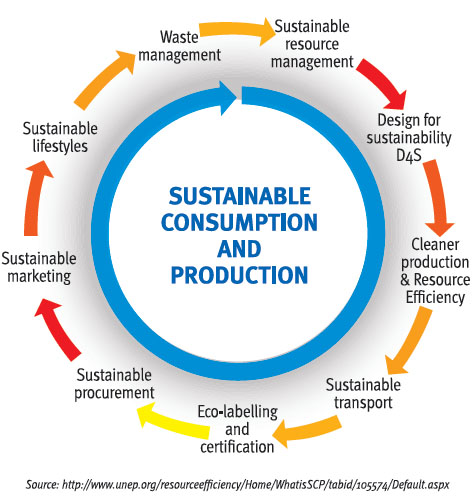Demystifying Sustainable Consumption & Production
Introduction
Growth and development has revolutionised trade and commerce globally and has improved the standard of living in several countries across the world. However, this has also led to increasing resource consumption, waste, pollution and widening of the gap between the rich and the poor. Several studies have highlighted that if the current trend continues, our planet will not be able to meet the resource demand. Given this scenario, there has been a lot discussion, deliberation and development at the global level, pertaining to the consumption of resources. Eco-efficiency, clean production, factor 4 production were some of the strategies used to address this which finally culminated into the concept of Sustainable Production and Consumption (SCP).
Understanding SCP
The 17 Sustainable Development Goals (SDGs) recently ratified by 193 UN Member countries cover key issues that need to be addressed by all countries so as to translate sustainable development into reality by 2030. The concept of SCP is closely linked to sustainable development and is the 12th SDG listed. Sustainable consumption and production aims at optimum utilization of resources, increasing net welfare gains from economic activities by reducing resource use, reduction in degradation and pollution along the whole lifecycle, while increasing quality of life. It also requires a systemic approach and cooperation among actors operating in the supply chain, from producer to final consumer. Governments have come together and through legal and governance frameworks, are working to achieve this. However, there is a need to have greater participation from the private sector, civil society and individuals to make this a reality.

Role of Consumers
As individuals and as sustainable consumers we can positively contribute to achieving this goal, especially with regard to consumption. As sustainable consumers we can buy products and services that conform to environmental regulations, espouse mechanisms for the judicious use of resources, incorporate effective disposal and treatment systems for waste and by products, use recycled materials, strive and adopt mechanisms for lowering their carbon and ecological footprints in the full life cycle of the product/service and contribute to the local economy where they are located.
Thus we need to be more aware and conscious of the multifarious products and services available in the market, so as to make informed choices. As our consumption patterns increase especially during festivals, the next section will discuss this in the context of the Christmas season.
Sustainable consumption and production (SCP) is about "the use of services and related products, which respond to basic needs and bring a better quality of life while minimizing the use of natural resources and toxic materials as well as the emissions of waste and pollutants over the life cycle of the service or product so as not to jeopardize the needs of further generations". - Oslo Symposium in 1994
Facts on consumption patterns
- US and Canada, with 5.2% of the world's population, are responsible for 31.5% of consumption. South Asia, with 22.4% of the population, is responsible for 2% of consumption.
- In 2005, China used 26% of the world's steel, 32% of rice, and 47% of cement. Though their per-capita resource consumption is low, with their large populations, China and India will surely be amongst the top superpowers of consumption.
UNDP Human Development Report 1998, http://www.undp.org, Worldwatch Institute, 'State of the World 2004: The Consumer Society', Worldwatch Institute, 'State of the World 2006: The Challenge of Global Sustainability'.

